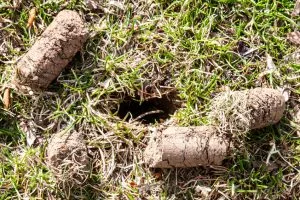The grass is always greener on the other side of the fence. But maybe it’s because your neighbor puts a little extra effort into maintaining his lawn. He mows, waters, fertilizes, and even aerates. You’ve heard the term, but what does aerationdo to make a lawn so lush and green?
What Is Aeration?
Often called core aeration, coring, spiking, or soil cultivating, aeration is the process of boring holes in the soil below the grass. This allows air, water, and nutrients to better penetrate the soil and reach the roots. In the simplest terms, these holes let your lawn breathe, which in turn, encourages growth.
The process involves tools that range from manual equipment to powered machines. All of them have spikes that leave behind a series of perforations in their wake as well as a scattering of soil plugs. The plugs eventually dissolve back into the soil.
Why Do It?
Year round, your lawn experiences a lot of wear and tear. People and pets trample on it regularly during the warmer months, compacting the soil and leaving behind a layer of thatch, a buildup of dead grass and debris. Snow, ice, and rain contribute to soil compaction as well. Even the act of mowing takes a toll on the turf. Aeration helps combat this kind of damage.
What Does Aeration Do?
Overall, aeration improves the health of your grass by promoting growth and strengthening the root systems. More specifically, it helps your lawn in the following ways:
- Enables the flow of oxygen to the root systems.
- Helps manage thatch.
- Reduces soil compaction.
- Improves grass health and resilience.
- Minimizes maintenance needs.
- Reduces stress from drought, heat, and temperature fluctuations.
- Improves the soil’s intake of nutrients.
- Enhances water absorption and minimizes runoff and puddling during irrigation, therefore saving you money on water bills.
Timing Is Everything
Healthy lawns benefit from a yearly aeration. But if your lawn is lacking, do it twice a year. The best time to perform the task is during the growing season. Cool season turf grasses like Kentucky bluegrass and ryegrass should be aerated in the spring or fall. Aerate warm season grasses like zoysia and Bermuda anytime from the middle of spring through the summer.
A few more tips for aerating:
- Make holes around 1/2 to 3/4 of an inch diameter, 2 to 3 inches deep, and 2 to 3 inches apart.
- Your lawn benefits from a thin layer of thatch, but more than a half-inch thick requires aeration.
- Aerate when the soil is moist, after a rain or good watering.
- Performing this task is most productive before seeding and after fertilizing.
- Equipment with hollow spikes pulls out plugs better than solid ones.
Proper aeration is labor intensive and requires professional-grade equipment, so it’s often best to call in a lawn-care expert. Contact Free Spray Lawn Care at 419-529-5296 today. We’ll do the dirty work and you can enjoy the results.



Comments (0)
Thanks for your comment!
Thanks for your feedback! Your comments have been successfully submitted! Please note, all comments require admin approval prior to display.
Error submitting comment!
There is a problem with your comment, please see below and try again.